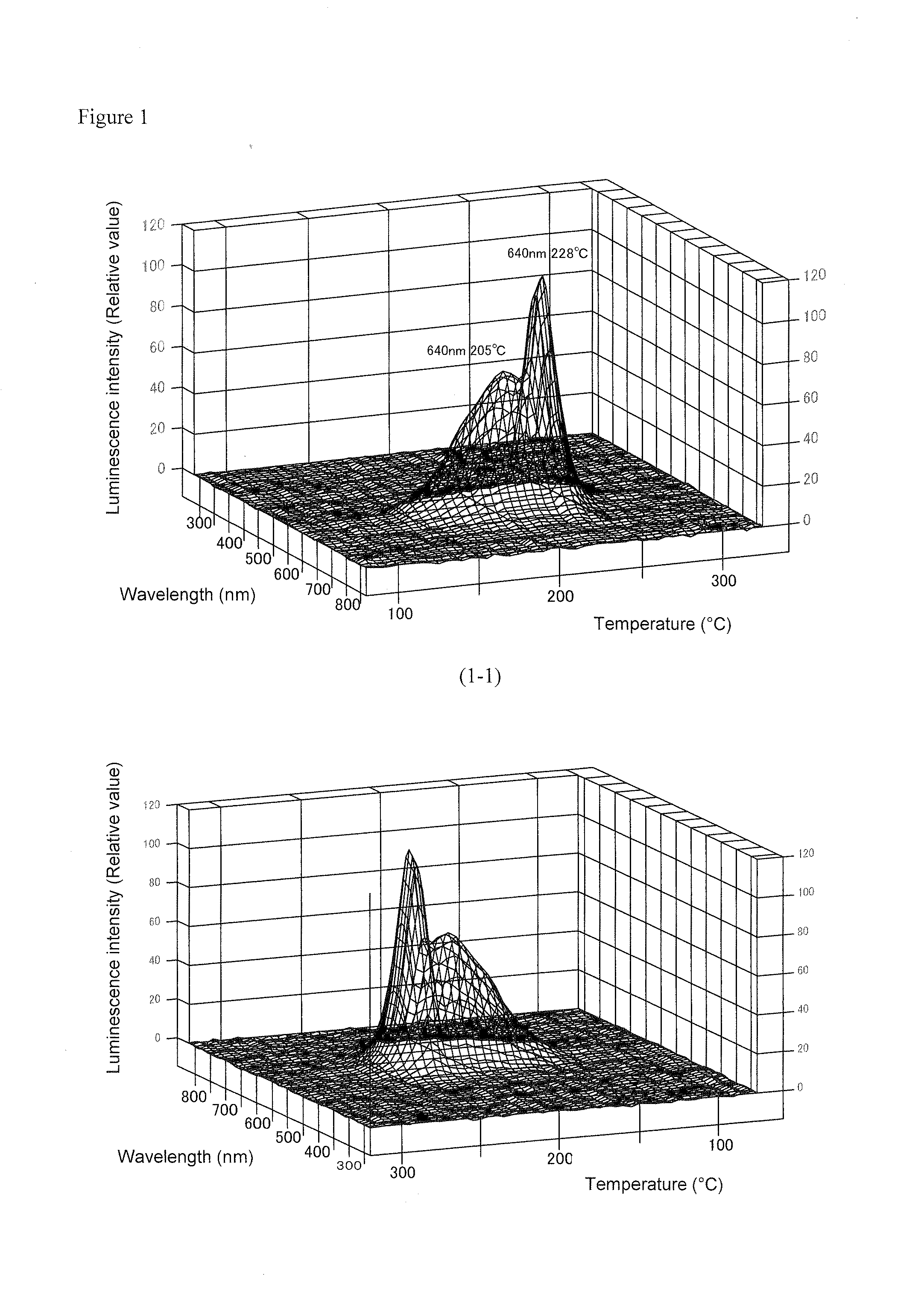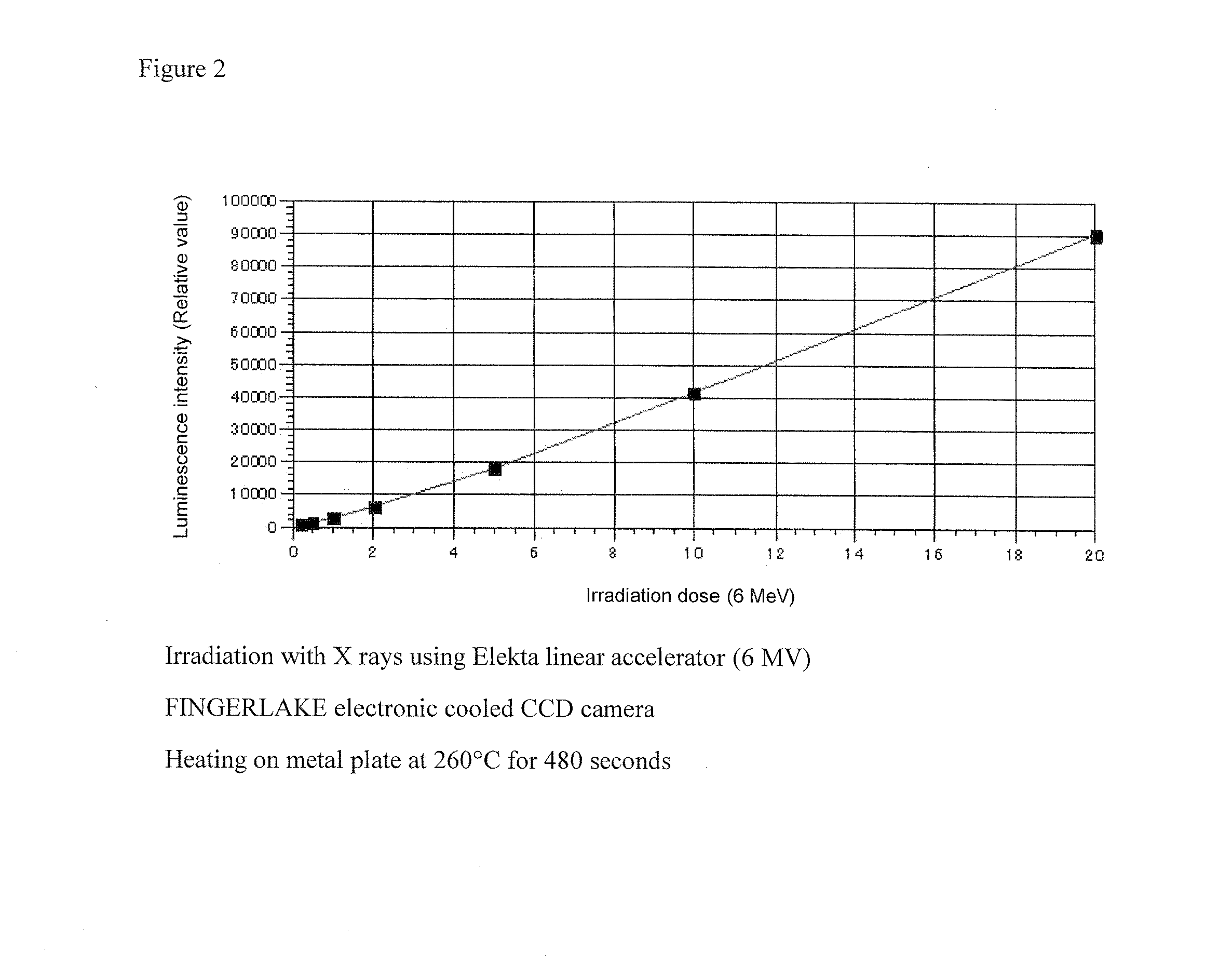Manganese-containing lithium triborate thermoluminescent phosphor, and method for producing same
a technology of thermoluminescent phosphor and manganese, which is applied in the direction of tenebresent compositions, chemistry apparatus and processes, and light sources, etc., can solve the problems of inability to obtain in-plane sensitivity coefficient, inability to accurately measure dose absorbed by biological tissues by sensors having a different effective atomic number, and inability to correct disrupted images resulting from uneven coating of photoreceptors. , to achieve the effect o
- Summary
- Abstract
- Description
- Claims
- Application Information
AI Technical Summary
Benefits of technology
Problems solved by technology
Method used
Image
Examples
reference example 1
[0060]Equimolar amounts of lithium tetraborate (Nacalai Tesque, Inc.) and boron oxide (Koso Kagaku Yakuhin K. K.) were fired at 800° C. for 2 hours to prepare lithium triborate. The lithium triborate and manganese dioxide (Koso Kagaku Yakuhin K. K.) were mixed and heated in air at 700° C., 750° C. or 800° C. After the resulting products were irradiated with 20 Gy of X rays, they were heated from 140° C. to 240° C. at a temperature increase rate of 0.5° C. / sec and the luminescence intensity was measured. The results are shown in FIG. 4. The symbols a, b and c in FIG. 4 indicate the examples in which the heating temperatures were 700° C., 750° C. and 800° C., respectively.
[0061]As shown in FIG. 4, the products of these examples had low luminescence intensity. FIG. 5 shows optical micrographs of the products. The black particles observed in FIG. 5 (those indicated by the arrows in the figure) are manganese dioxide microparticles, showing that unreacted manganese dioxide remained. From ...
example 1
[0062]Step A1: Lithium tetraborate (Nacalai Tesque, Inc.), boron oxide (Koso Kagaku Yakuhin K. K.) and manganese dioxide (Koso Kagaku Yakuhin K. K.) were mixed in the ratios shown in Table 1. It is to be noted that the amount of the manganese dioxide was 0.4 mass % relative to the total amount of the boron oxide and the total amount of the lithium tetraborate.
[0063]Step A2: The mixtures were each placed on a platinum plate and fired in an electric furnace at 825° C. for 4 hours.
[0064]Step A3: The fired products and additional lithium tetraborate in the amounts shown in Table 1 were mixed and fired at 825° C. for 4 hours to give manganese-containing lithium triborates.
[0065]After the thus obtained manganese-containing lithium triborates were irradiated with 20 Gy of X rays, they were heated from 140° C. to 240° C. at a temperature increase rate of 0.5° C. / sec and the luminescence intensity was measured.
[0066]The results are shown in FIG. 4 and Table 1. The numbers shown in FIG. 4 ind...
example 2
[0069]Manganese-containing lithium triborates were obtained and evaluated, in the same manner as in Example 1-5 except that the firing conditions applied in the steps A1 and A3 were changed within ranges of 775 to 850° C. and 0.5 to 16 hours. The results are shown in FIG. 6. FIG. 6 shows differences in sintering time in the horizontal direction and differences in sintering temperature in the vertical direction. Each number shown at the bottom right indicates relative luminescence intensity.
PUM
 Login to View More
Login to View More Abstract
Description
Claims
Application Information
 Login to View More
Login to View More - R&D
- Intellectual Property
- Life Sciences
- Materials
- Tech Scout
- Unparalleled Data Quality
- Higher Quality Content
- 60% Fewer Hallucinations
Browse by: Latest US Patents, China's latest patents, Technical Efficacy Thesaurus, Application Domain, Technology Topic, Popular Technical Reports.
© 2025 PatSnap. All rights reserved.Legal|Privacy policy|Modern Slavery Act Transparency Statement|Sitemap|About US| Contact US: help@patsnap.com



